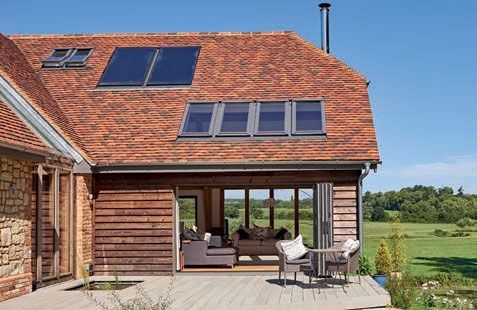
Solar thermal panels have been installed on the roof of this barn-style abode. The house was designed by Welsh Oak Frame
Solar thermal panels collect energy from the sun and re-purpose it to power your home’s domestic hot water (DHW) supply. There are two main types: evacuated tube and flat plate. The former can be likened to a thermos flask. It comprises a series of individual collectors, each of which is made up of a twin-wall tubing system with a vacuum between the two layers. Radiation from the sun passes through to the inner cylinder, which contains a heat-storing fluid, which is transferred to your heating system.
Flat plate setups, on the other hand, are formed from slim panels covered by a layer of glass or Perspex. A series of pipes is fitted inside the structure, through which a heat transfer liquid is pumped. The unit is insulated at the bottom and sides to hold onto as much warmth as possible. Because of their slim profile, flat plate collectors can easily be mounted on the roof to sit flush with the tiles. With both options, the heat transfer liquid (normally a mixture of water and antifreeze) is circulated through copper pipes within the collector unit. From here, it is sent to a heat exchange coil in your home’s hot water cylinder so it can be transmitted to your DHW supply.